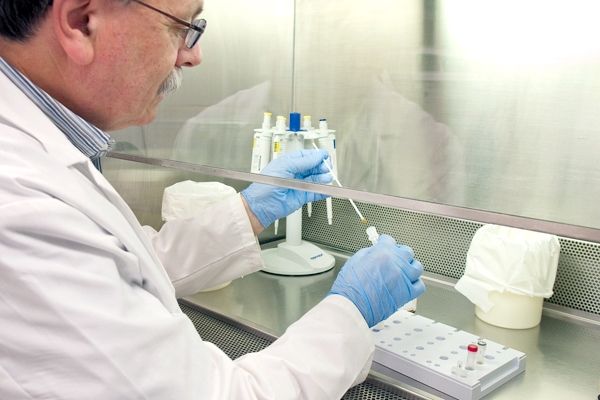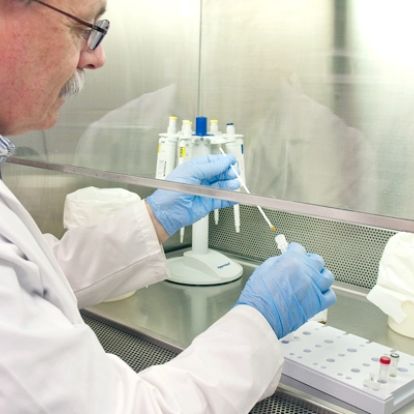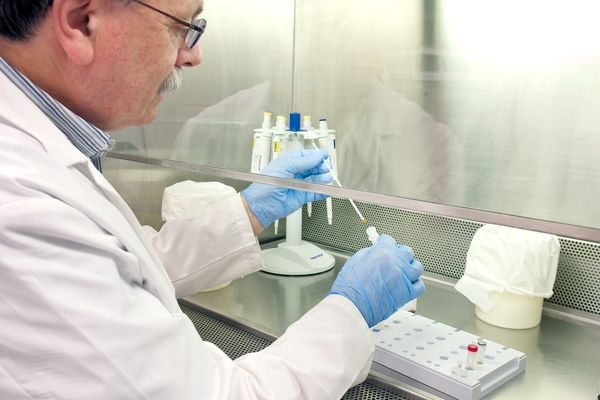Effective immediately masking is required for everyone when present on all inpatient units, in the Emergency Department (ED), the Urgent Care Centre (UCC), and the Children’s Outpatient Centre (COPC).

When it comes to an important medical test, you can't ask for it to be much more than fast and incredibly reliable. And that's exactly what our new test for C. difficile has turned out to be. Just ask Larry Weiler, a senior lab technologist in microbiology. He's been in charge of running the test since July when it was first fired up at KGH.
“This new test is a huge improvement,” says Weiler. “The odds of the old test picking up the presence of C. difficile were about 70 per cent. This one detects it 95 to 99 per cent of the time. It's helping eliminate false negatives almost entirely.”
Weiler is one of eight people now trained to carry out the test here. It's called the Illumigene C. difficile Assay and it can run up to 10 samples at a time. Each one can be turned around in an hour-and-a-half after it reaches the lab. This allows health-care providers on the floor to move quickly to identify, treat and isolate a patient with C. diff.
“To know we are contributing to better patient care in this way is exciting,” says Weiler.
KGH's Medical Director of Infection Prevention and Control, Dr. Gerald Evans, is also excited by the new test and our overall progress this year containing C. difficile.
“Except for a brief outbreak in the summer which was accounted for by our changeover to the more sensitive test, we have been outbreak-free for most of the year,” he says. “That ability to really find all the cases and make sure they are isolated is, I think, one of the pivotal strategies that is helping us reduce C. diff. here.”
The new test is just part of our overall effort to eliminate all preventable harm to patients.
Evans says another move that's helped was our decision earlier this year to stop testing aggressively for the bacteria Vancomycin-resistant Enterococcus (VRE).
“After years of worrying about it, it became clear that it didn't actually produce any major problems,” says Evans. “We've stopped doing widespread screening for it and instead put our resources into tackling C. diff and it's paying off.”
Evans says getting rid of the carpets in patient care areas is also helping as it makes environmental cleaning easier.
Our improved hand hygiene rates across the hospital are also a big factor. Evans thinks we may have reached a tipping point and that 100 per cent compliance is within reach. In November, the hospital's overall compliance rate was 91.5 per cent.
“There has been a lot of buy-in from all the groups in the hospital. It's become second nature for people now,” he says. “It's like when you get in your car and don't put your seatbelt on and you know something is wrong. When you are up on the ward and you walk into a room and you haven't washed your hands, you know something is wrong and you go back out and do it.”
Another piece that's recently fallen into place, says Evans, is the hiring of a new infection prevention and control manager. Darlene Campbell came to KGH from Providence Care in October to help oversee the program, which is growing more complex all the time.
Looking forward, the next big step will be the implementation of an antibiotic stewardship program across KGH. This program will look at reducing the inappropriate use of antibiotics, as they are a known to trigger C. diff infections.
“The hospital has it as one of our highest priorities to get this established,” he says.
Together, all these initiatives will help keep our patients safe while they are here, says Evans.
“Ultimately, all of this is going to benefit patients by making sure our hospital-acquired infection rates are low and people can feel comfortable coming here.”





